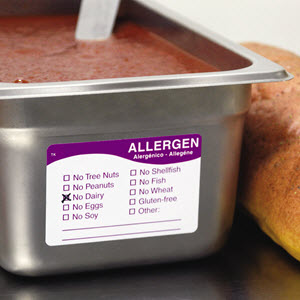Seven Trends to Watch in the Food Labeling Industry
Posted on 30th Jun 2017

The food labeling industry is in the midst of several emerging trends. For the most part, new food labeling programs are being introduced to benefit food manufacturers, retailers marketing food products such as grab and go food items, the customers who purchase these products, and our environment.
In fact, when it comes to grab and go food items, some would say that food labeling systems have helped elevate these products from “second-class” food to food that is viewed as wholesome and healthy as well as delicious. This shift happened in large part because today’s food labeling systems provide the customer with considerably more information about the product they select, helping to build trust.
So what are some of the changes occurring in the food labeling industry? Here are seven to watch:
Branding: Branding creates a name, visual symbol, even a feeling, that consumers quickly recognize and associate with your company or product line. This mean that even the labels placed on grab and go food products, for instance, should reflect the brand standards of the company manufacturing the product. This helps purchasers distinguish your company from its competitors.
No more preprinted labels: Preprinted labels originally designed to save time and costs for food retailers, are now viewed as a hindrance. Today’s retailers want to be able to change labels quickly and easily to help market the product, end waste, and meet regulatory requirements and other business needs. This is the reason so many are now using food label terminal systems. Retailers with multiple locations want a centralized terminal system that allows them to simultaneously update grab and go food label information wherever those food products are sold.
Allergen information: As of January 2006, the Food Allergen Labeling and Consumer Protection Act requires foods containing major allergens such as milk, eggs, fish, crustacean shellfish, peanuts, tree nuts, wheat, and soy to note these allergens on the label in plain language. Providing this information helps protect health, however, these regulations can and do change. This necessitates having a food labeling system that can make the required updates, in one retail location or many.
"Today’s food labeling industry wants food labeling programs that help them change labels quickly and easily"
Flexibility: Some food producers market food internationally. Different countries often have different regulatory requirements as to what product information must be included on the label. Food manufacturers must have the ease and flexibility to address these specific labeling requirements wherever the items are sold.
Green and sustainable: Today’s customers are very focused on how the items they select impact the environment, and this includes the labels placed on them. To address this, companies such as DayMark have taken steps to have their dissolvable labels certified and accredited by third-party organizations. This shows the company’s commitment to promoting sustainability, eliminating waste, and protecting the environment and human health.
Consistency: Along with the information on food labels being accurate and providing the required information, customers want consistency—especially when it comes to grab and go food products. The consistent presentation of information makes it easier for the consumer to make an effective purchasing decision.
End food waste: In the United States, food waste is estimated at between 30 and 40 percent of the entire food supply. This corresponds to approximately 133 billion pounds of food, costing close to $200 billion. Much of this is wholesome, healthy food that could help needy families instead of being delivered to landfills. To address this situation, the food industry is adopting clearer, more easily understandable expiration date terminology and depending on food-labeling systems to convey this information to the consumer.
It is clear that food labels carry a huge workload. They carry marketing information for food manufacturers and retailers while also helping consumers to make informed food selections and protecting human health and the environment. This heavy lifting is evident in the trends now emerging in the food-labeling industry. Tying them all together is a need for flexible labeling systems that will adapt to the landscape as it continues to evolve.
To find out what information is required on food labels, click here .
Information on the FDA Food Labeling Nutrition Template can be found here .
For more information on food labeling, grab and go food labeling programs, and trend in the food labeling industry, contact a DayMark Representative.


